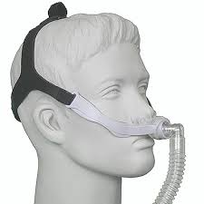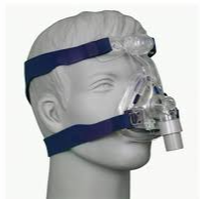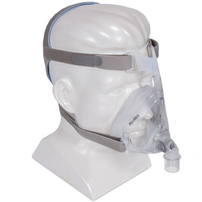|
When your bilevel (BiPAP) machine or portable ventilator (Trilogy) is delivered, a respiratory therapist from a durable medical equipment (DME) company will bring a variety of mask options and recommend the one that will be the most appropriate for you. This may depend on how you breathe at night and how well the different masks fit. Cough assist machines will arrive with the appropriate mask included.
|
|
These are the most common types of masks and interfaces for people living with ALS:
Nasal PillowsWith just two little cushions that seal at the base of your nostrils, this is the lightest and most compact interface option. Nasal pillows are generally good for people who breathe through their nose when sleeping. Because of its low profile, you can still wear glasses, read, watch TV, talk, and eat with nasal pillows in place. If you have a lot of facial hair, nasal pillows may help you get the tightest seal. If you tend to breathe through your mouth at night, nasal pillows may not be your best option, though you can ask about attaching a chin strap that can help keep your mouth closed.
|
Nasal Mask/InterfaceThe nasal interface is larger than nasal pillows but less bulky than a full face mask. Triangular in shape, it sits on your face and covers your full nose. The nasal interface is generally good for people who breathe through their nose when sleeping. If you tend to breathe through your mouth at night, a nasal interface may not be your best option, though you can ask about attaching a chin strap that can help keep your mouth closed.
|
Full Face MaskThe traditional full face mask is more bulky than the other interfaces, but it does allow the option of breathing through your nose or mouth. This can be especially helpful if you tend to get congestion that makes it harder to breathe through your nose. If your air pressure settings are high, the full face mask will be the most comfortable option. This larger mask can make it hard to read, watch TV, or sleep on your side or stomach. There is also a higher chance of air leaking with a full face mask.
|
If your mask or interface is uncomfortable or doesn’t feel like it is fitting correctly, schedule another appointment with the respiratory therapist who set everything up. Making adjustments or trying a different mask or interface may solve the problem. It may also just take some time to get used to wearing a mask and using a new device. The benefits of using a bilevel or portable ventilator in bilevel mode are too great to give up because something doesn’t feel right at first.





